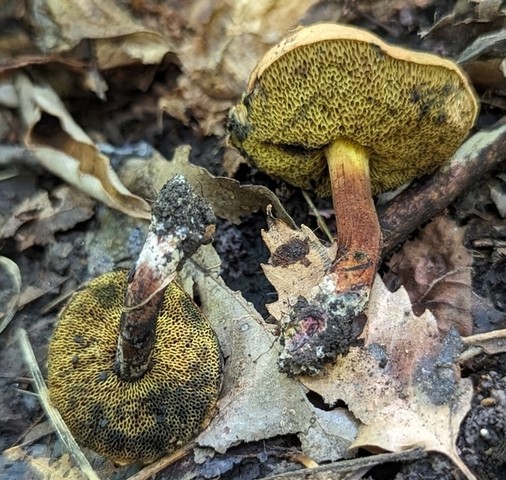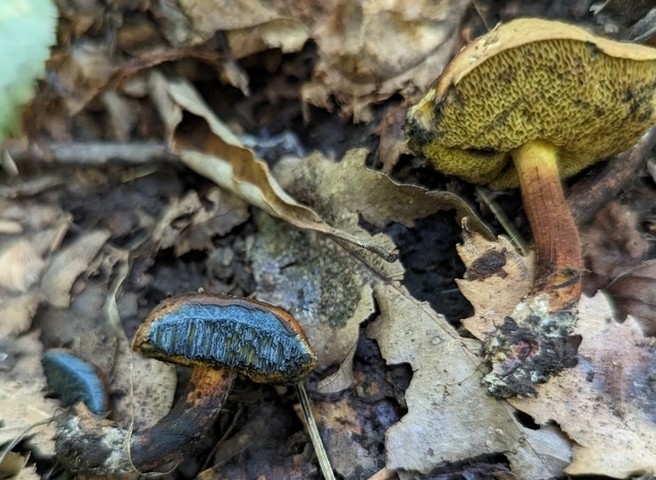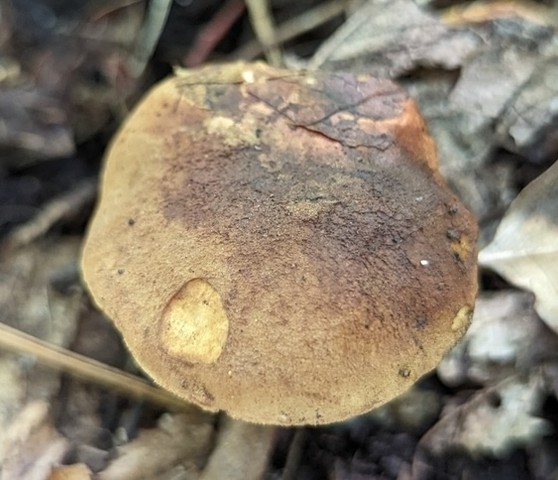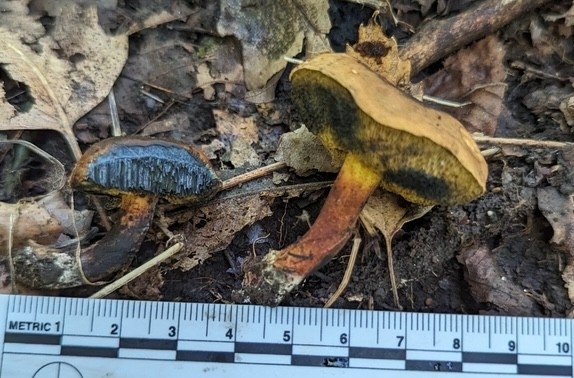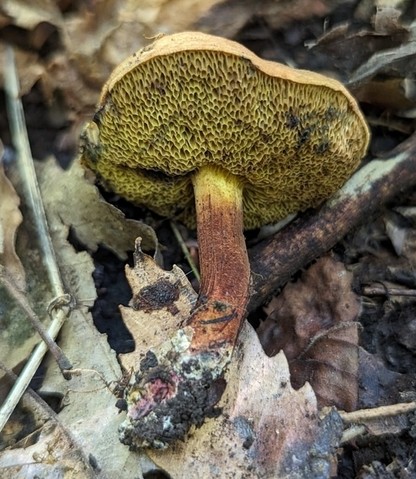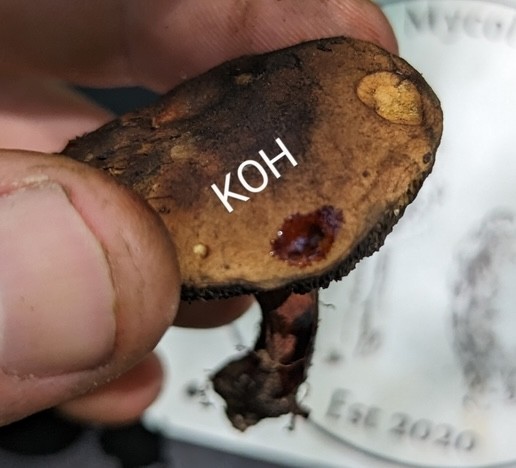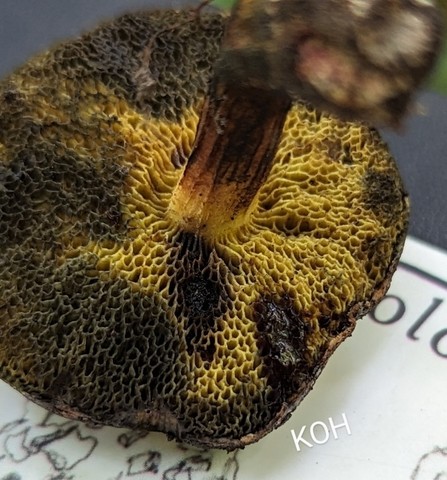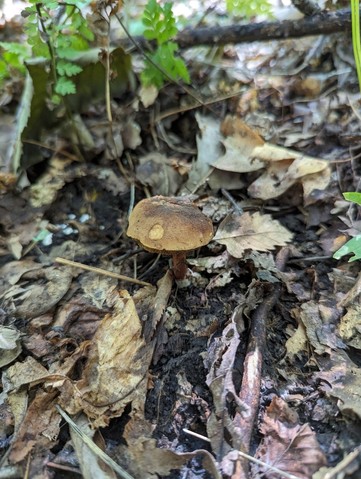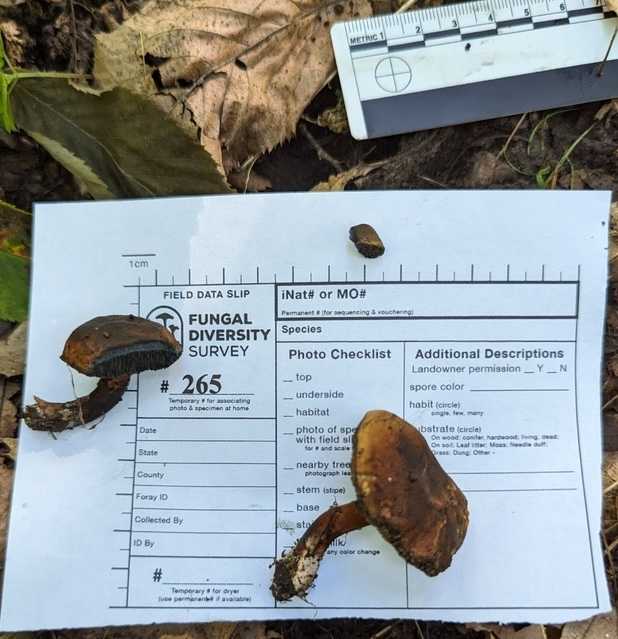Dirty Bolete
Cyanoboletus cyaneitinctus
Life > Fungi > Basidiomycota > Agaricomycotina > Agaricomycetes > Agaricomycetidae > Boletales > Boletaceae > Cyanoboletus
Description
The Dirty Bolete (Cyanoboletus cyaneitinctus) is a mycorrhizal mushroom that can be found growing in woodland soil and lawns adjacent to Oaks and other symbiotic trees in Eastern North America. It can be found in the summer and fall growing singularly or (rarely) in small groups.
The cap shape is cushion-shaped to evenly rounded. The cap color is different hues of brown or maroon. The cap texture is finely powdery when young, turning smooth with age. When wet, it can be slightly tacky, with leaves or other debris commonly adhering to the surface as it dries. It bruises blue quickly and readily when handled.
The fertile surface under the cap is composed of yellow, circular to angular pores that also bruise blue where handled.
The stem is yellow commonly transitioning to a reddish color towards the base.
The inner flesh (context) of the mushroom is generally a similar color to the stem, which readily bruise blue when cut.
Though considered to be edible in the past, it has been determined to be a bio-accumultor of arsenic from the soil (Pavelle, 2015), which makes its edibility iffy.
July 26th, 2023 Field Notes - Indian Cave State Park:
Growing scattered in low East-facing mixed oak/hickory woodland.
- Cap brownish-tan with some maroon hues and velvety, bruising darker.
- Pore surface dingy yellow with irregular shaped pores that quickly turn dark blue when bruised.
- Stipe yellow at apex, quickly turning reddish brown clear to the base, also bruising dark blue.
- Basal mycelium white.
- Interior flesh yellowish, quickly turning dark blue where cut.
Additional Info
- Taste: acidic to mild
- Smell: not distinctive to reminiscent of Portabellas.
- KOH: orangish on pileipellis, dark buff-orange on pore surface.
- Ammonia darkening on pileipellis, pore surface, and stipe.
DNA ITS Barcode: GAACGCACCTTGCGCTCCTCGGTATTCCGAGGAGCATGCCTGTTTGAGTGTCATCGAATTCTCAACCATGCCCCTTTGTCAAAAGGACATGGCTTGGACTTTGGGAGCCTTGCTGGCCTTTTTGGTCAGCTCTCCTGAAATGCATTAGCGATGGGTGGGCAAGTCTTCATTAGAGACGTGCACGGCCTTCGACGTGATAATGATCGTCGTGGCTGGAGCGTCTTTATTCTTGCGATCCGTCCTCGCTCACAATCTCTGCTAGCCTTGGGTTAGCTTTTGGCTATTAGTTCGGTCACGAGACCTGACGAACGTCAGAGGTGCACCCCCAAGGACTGGTCGATTTCGAAACTTGACCTCAAATCAGGTAGGATTACCCGCTGAACTTAA
References
Farid, A; Bessette, AE; Bessette, AR; Bolin, JA; Kudzma, LV; Franck, AR; Garey, JR. 2021. Investigations in the boletes (Boletaceae) of southeastern USA: four novel species and three novel combinations. Mycosphere. 12(1):1038-1076. https://www.mycobank.org/details/19/10098005
Kuo, M. (2004, September). Boletus pulverulentus. Retrieved from the MushroomExpert.Com Web site: http://www.mushroomexpert.com/boletus_pulverulentus.html
Pavelle, S. (2015, July 23). Cyanoboletus cyaneitinctus. The Bolete Filter. https://boletes.wpamushroomclub.org/product/boletus-pulverulentus/
Thilini Chethana. (2022, May 25). Cyanoboletus cyaneitinctus - Facesoffungi number: FoF 10465 - Faces Of Fungi. Faces of Fungi. https://www.facesoffungi.org/cyanoboletus-cyaneitinctus/
Created December 15, 2025 at 10:41 AM
